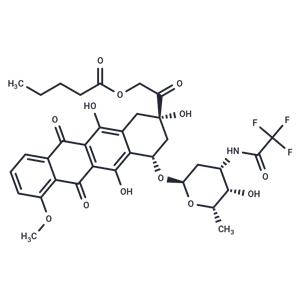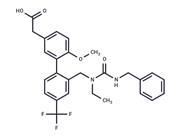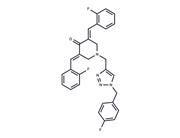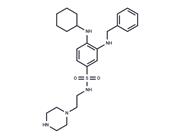| Name | Valrubicin |
| Description | Valrubicin (AD-32) (AD 32) inhibits TPA- and PDBu-induced PKC activation (IC50s: 0.85 and 1.25 μM) and has antitumor and anti-inflammatory activity. |
| Cell Research | UMSCC5 cells exposed to Valrubicin (2 μM for 3 h), a single dose of radiation (400 cGy), or the combined treatment are cultured for a further 12, 24, or 48 hours. At these times, the cells are collected by trypsinization (0.25%), washed in PBS, and fixed at 5 × 10^6 cells/mL with 95% ethanol. Cells are incubated with ribonuclease (50 μg; 70-90 Kunitz units/mg for 30 min), and the resulting pellet resuspended in and incubated with propidium iodide (0.05 mg/mL for 10 min). The DNA content of the samples is determined by flow cytometry according to standard technique [2]. |
| Animal Research | Hamsters with cheek pouch tumors of 100 mm2 are randomly assigned to one of five treatment groups. Momentarily anesthetized animals each receives once a week × 3 injections (27 g × 0.5-inch needle: 0.1 mL administered slowly to the base of the lesion) of Valrubicin (3, 6, or 9 mg) or drug vehicle (Cremophor: alcohol;1:1 by volume; NaCl diluent 12). A further group of animals receives anesthesia but no direct tumor treatment (control). Individual tumor sizes are measured with calipers at weekly intervals for 4 weeks, at which time the animals are sacrificed [2]. |
| In vitro | Valrubicin inhibits the binding of [3H]PDBu to PKC. Therefore, Valrubicin competes with the tumor promoter for the PKC binding site and prevents the latter from both interacting with the phospholipid and binding to PKC [1]. Valrubicin shows cytotoxic activity against squamous cell carcinoma (SCC) cell line colony formation, with IC50s and IC90s of 8.24 μM and 14.81 μM for UMSCC5 cells, 15.90 μM, 29.84 μM for UMSCC5/CDDP? cells, and 10.50 μM, 19.00 μM for UMSCC10b cells, respectively [2]. |
| In vivo | Valrubicin, administered at doses of 3, 6, or 9 mg, effectively reduces tumor growth through intratumoral injections in hamsters by the third week. When 6 mg of Valrubicin is used in conjunction with minimally cytotoxic irradiation (ranging from 150, 250, or 350 cGy), it induces significant tumor shrinkage in the hamster model [2]. Additionally, at a concentration of 0.1 μg/μL, Valrubicin markedly decreases the infiltration of neutrophils in TPA-challenged biopsies at 24 hours and mitigates chronic inflammation in mice. Furthermore, Valrubicin reduces the expression of inflammatory cytokines in the acute experimental setup [3]. |
| Storage | Powder: -20°C for 3 years | In solvent: -80°C for 1 year | Shipping with blue ice. |
| Solubility Information | DMSO : 125 mg/mL (172.74 mM)
H2O : Insoluble
|
| Keywords | Valrubicin | Protein kinase C | PKC | Inhibitor | inhibit | Antibiotic | AD32 | AD 32 |
| Inhibitors Related | Neomycin sulfate | Ampicillin sodium | Doxycycline (hyclate) | Cefaclor monohydrate | Kanamycin sulfate | G-418 disulfate | Sulfamethoxazole sodium | Metronidazole | Doxycycline | Penicillin G sodium salt | EDTA copper(II) disodium salt | Dexamethasone |
| Related Compound Libraries | Bioactive Compound Library | Kinase Inhibitor Library | Anti-Cancer Clinical Compound Library | Drug Repurposing Compound Library | Inhibitor Library | Anti-Cancer Approved Drug Library | FDA-Approved Kinase Inhibitor Library | FDA-Approved Drug Library | Immunology/Inflammation Compound Library | Bioactive Compounds Library Max | TGF-beta/Smad Compound Library | Anti-Cancer Drug Library |

 United States
United States



